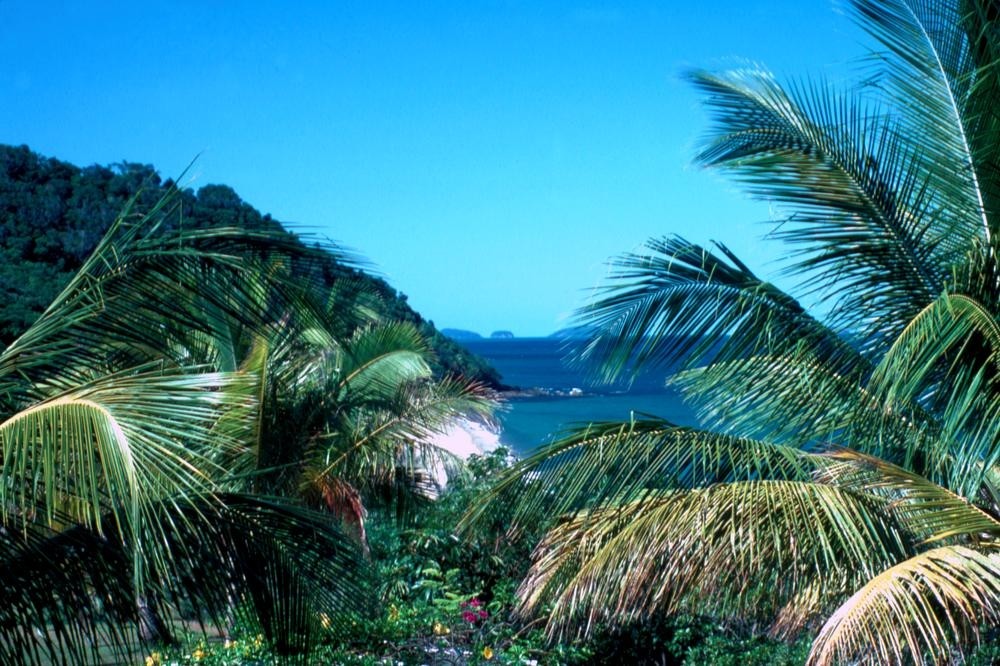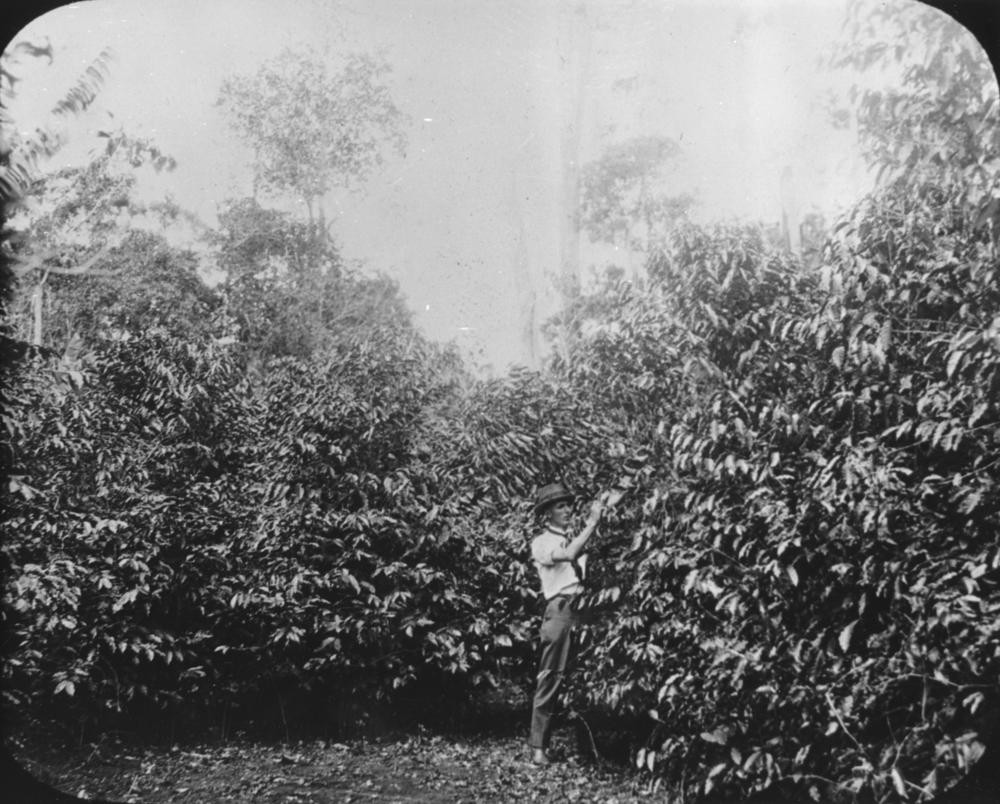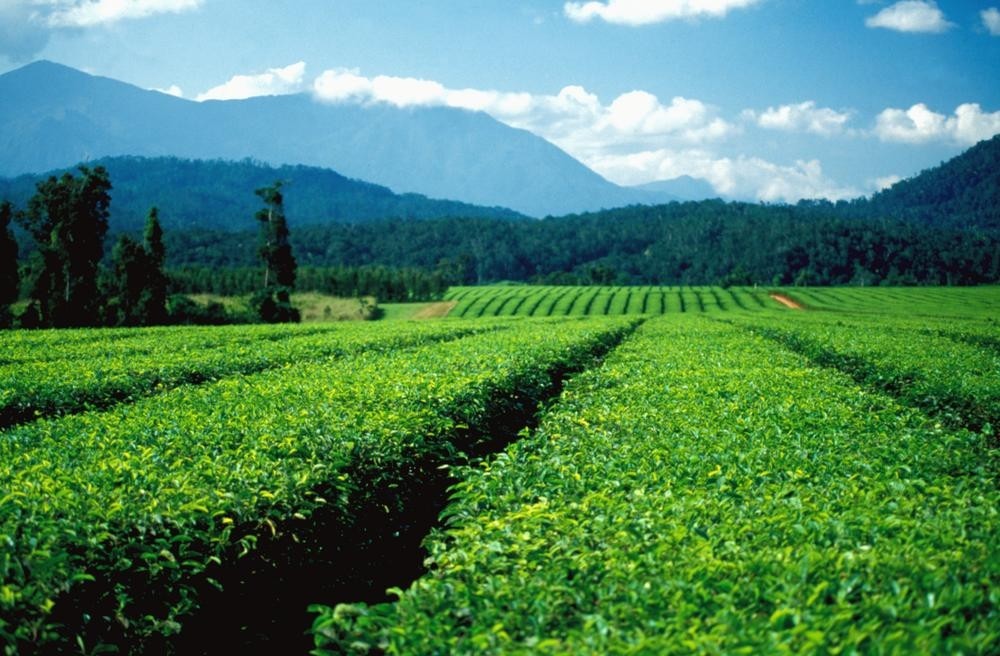The coffee barons of Bingil Bay and their legacy of tea
By Simon Miller, Library Technician, State Library of Queensland | 3 July 2012
In 1886 four brothers, James, Leonard, Sidney and Herbert Cutten selected a patch of land on the coast north of Mission Beach at Bingil Bay. They named their new property Bicton and set about the hard, tedious work of turning dense forest into productive land. The results of their work are evident in this description of the property from the North Queensland Register of 1 May 1899. http://nla.gov.au/nla.news-article84406345

View through palm leaves to Bingil Bay, Barnard Islands, north Queensland, 1983
From the sea the estate presents a unique and picturesque appearance. Clump Mountain (1338ft.), forms the dominating feature of the immediate background; but there are also numerous precipitous hills, some isolated, some connected by steep ridges and razorbacks, and to the North the country is broken into many ranges and peaks. The estate occupies, a valley, not smooth and green and flower decked, like the "long, low valley of Bag-dad ;" but a valley blocked, it would seem, by a steep conical-shaped hill, three miles off, and into which the elbows of opposing hills obtrude. The debouchement of the valley forms the unique feature. Clump Mountain sends its eastern buttress out to the verge of the sea, and to the North—a little over a mile—there is the abrupt termination of a lesser height, plumper and softer of outline. A cliff 100ft high at its beginning on the south, forms the edge of a plateau which has an easy down grade to the north, on which the house and the older cultivated part of the estate are situated.
This cliff is the conspicuous item, in the landscape. The seaward aspect is covered with the rich greenness of couch and buffalo grass ; but the pinkish red soil of the country shows up along the edge, which by a grade as even and consistent as if made by art, descends parallel with the beach from its 100ft to nothing, ending half way across the opening of the valley in a curve or flourish that might have been designed by some ingenious landscape gardener. Below the cliff are cocoa-nut palms and native umbrageous trees, and up above show the roof of the hospitable home and the high-peaked, thatched covering of the fruit store and workshop, and byre, while up the steap hill sides extend the orchards and the pine plantation, and nearer at hand a dense grove of mango trees, acres of oranges, and acres of cocoa-nut palms waving a welcome with fronds glistening in the sun. ...
An idea of the area of the cleared parts may be obtained from the fact that here are about 700 mango trees in one grove—and such trees. Tall, dark masses of foliage, which "in the rich, ripe season gratifies the sense" with a pleasing variety of flavors. Of orange trees there are nearly 1200 ; and of pineapples there is no count—there they are in long regular rows up on the hill side, down steep ravines, across ridges—everywhere and anywhere. Bananas occupy the lower levels.
The chief coffee plantation is a couple of miles away up the valley, whence can he seen the roof of the sugar shed at the Mourilyan Harbor wharf. Here there are 80 acres, representing 80,000 plants, with an additional 10 acres ready for planting. These 80,000 plants occupy the place of what, two years, ago was dense jungle. They are set out in straight rows; and in the blossoming time—limited to a comparatively few hours—the whole area will be a mass of creamy white blooms of delicious, all-pervading fragrance. To keep the plantation supplied there are two nurseries, extensive places lightly thatched with palm fronds, and so situated as to command perennial supplies of water. The best part of the energy of the proprietors is how devoted to the cultivation of coffee, and its preparation for the market. By the study of all available works, but better still by hard, practical experience, the brothers have acquired enviable knowledge on the subject; and with such a magnificent piece of country, soil of unsurpassed fertility, meteorological conditions said to be about perfect for the growth of the plant, never-ceasing rivulets intersecting the estate, there can hardly be any doubt that they will enjoy success. At present they have machinery for treating the coffee on the water. The plant includes a pulper and a huller, of Gordon's make, the former being capable of treating four tons of cherry (the twin berries covered with sweetish pulp) per day.
The brothers had not brought about this transformation entirely by their own labour, but had established good relations with the local aboriginal population and enlisted their help.
Labor is, of course, an important item in such an undertaking, and the brothers have, by kindness, fair treatment, the payment of regular wages for regular work, overcome the philosophic disinclination of the natives of the country to manual work; and have at command quite a strong contingent of erstwhile savages. The blacks are erratic, no doubt, but by conciliatory methods and discreet firmness men and women who were until recently a source of trouble and annoyance, not to say of danger, to the pioneers, are being converted into beings who know the value of money and who appreciate the things which money procures.
The Cuttens planted tea as well as coffee but could not persuade their local labour force to undertake the constant picking cycle necessary for successful tea production. They had much greater success with their coffee, installing their own coffee mill and marketing the product successfully under their brand name of Bicton Coffee. The Cutten brothers prospered, extending their homestead and improving the property with a sawmill and a wooden railway line from the sawmill to the large stone breakwater that served as their warf and as shelter for their boats. They became known as the Australian Coffee barons.

Coffee plantation in Atherton 1927
They negotiated disasters and setbacks. A cyclone in 1890 caused serious damage and there was drought and subsequent fires in 1902. Acres of coffee trees were destroyed and Herbert Cutten was badly burned. James Cutten eventually sold his share to his brothers and went to live in Cairns where he worked as a draftsman. The brothers lost most of their labour force when the government moved to segregate the aboriginal population onto settlements and limit the numbers that were able to be employed. Then there was another cyclone in 1911.
The outbreak of World War 1 was the beginning of the end for the Cutten brothers enterprise with most of the ships that plied the coast, and which the brothers relied on for shipping their produce, taken away for war service, but the final blow came in the form of the great cyclone of 1918. Two cyclones battered the Queensland coast in that year, the first devastating Rockhampton and Mackay in January. The second cyclone struck in March and was one of the most powerful storms to ever strike the Queensland coast. Innisfail town was almost totally demolished and to the south in Bingal Bay and Mission Beach the winds were joined by a massive tidal surge that swept away the huge stone breakwater as it crashed against the cliff below the homestead. Practically the whole estate was destroyed and the brothers, who were now in their sixties, rebuilt their home but the orchards and coffee plantations were never restored.
The jungle was left to reclaim the estate until, in the 1950s, a legacy of the Cutten brothers and their Bicton estate was rediscovered. The discovery was made by Dr Alan Maruff, a doctor, born in India in 1911 and educated at the University of Calcutta. Dr Maruff had settled in Innisfail and after years of successful medical practice he was taken with the idea of growing tea. His wife's family had a home at Darjeeling and she noted the resemblance of the country around Innisfail to that famous tea growing area of India. Some time in the 1950s Dr Maruff searched for and found the Cutten brothers' estate and there in the rainforest was the remnant of the unsuccessful tea plantation that had been let grow wild. The original tea plants had grown into enormous trees with an undergrowth of tea plants and seedlings growing from the seed from these giant ancestors. Dr Maruff collected hundreds of seeds and seedlings which he planted in a nursery behind his surgery. These plants became the basis for a plantation which ultimately became the very successful Nerada Tea. This unexpected legacy of the pioneering Cutten brothers became the basis of a successful tea industry in Queensland but also in Papua New Guinea after Dr Maruff supplied seed from Nerada to new plantations being established there.

Nerada Tea Plantation on the Atherton Tableland, 1986
A detailed history of the Cutten brothers Bicton estate and the development of the tea industry can be found in The Lost Plantation : a history of the Australian Tea Industry by R. J. Taylor.
Historical information about Bingil Bay and surrounding areas can be found in Clump Point and District : an historical record by Constance Mackness.
Simon Miller - Library Technician, State Library of Queensland
Comments
Your email address will not be published.
We welcome relevant, respectful comments.